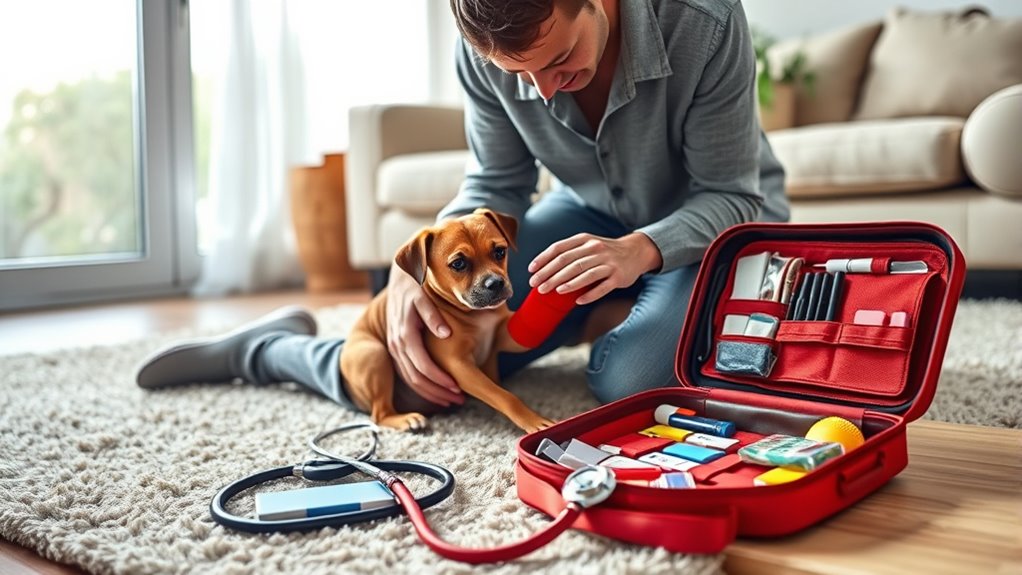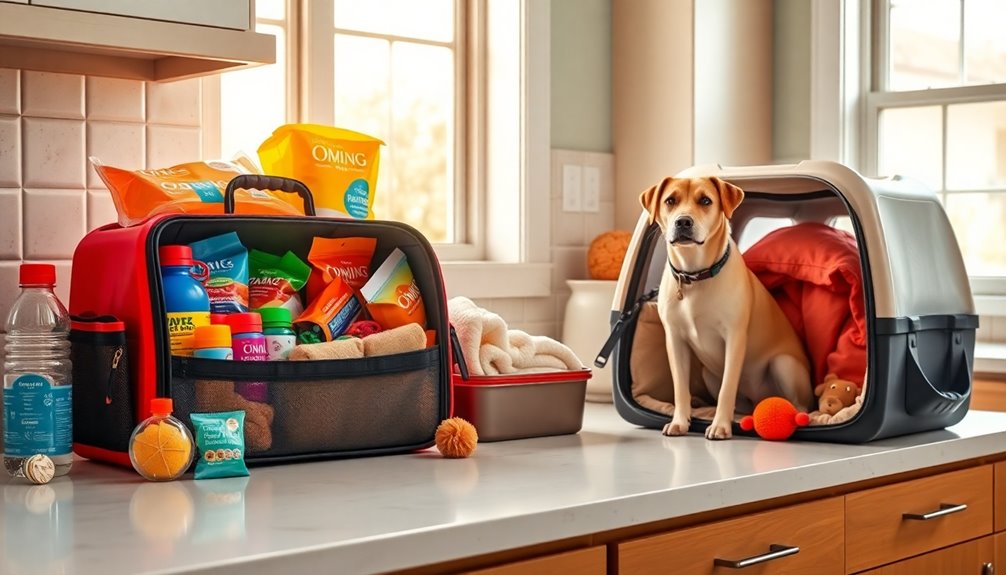To handle pet injuries and illnesses, stay calm and assess the situation quickly. For bleeding, apply gentle pressure with a clean cloth and keep the pet comfortable. If your pet ingests something toxic, remove the source and contact your vet immediately—do not induce vomiting unless advised. Know basic first aid techniques like CPR and stabilizing fractures. Being prepared and familiar with emergency steps helps you protect your pet—discover more about how to respond effectively in emergencies.
Key Takeaways
- Recognize signs of injuries or illness early and respond promptly to prevent worsening conditions.
- Use gentle pressure with gauze or a clean cloth to stop bleeding; avoid disturbing broken teeth or swelling.
- Remove toxic substances from your pet’s reach and contact a veterinarian or poison control before inducing vomiting.
- Keep a well-stocked pet first aid kit, including antiseptics, tweezers, and bandages, for quick response to minor injuries.
- Stay calm, perform CPR or rescue breathing if necessary, and always seek professional veterinary help for serious issues.

Have you ever wondered what to do if your pet suddenly gets injured or sick? When emergencies strike, staying calm and knowing basic first aid can make all the difference. One common issue pet owners face involves dental emergencies, which can be alarming and painful for your furry friend. If you notice bleeding from your pet’s mouth, broken teeth, or swelling around the jaw, it’s essential to act quickly. Gently examine their mouth if they allow it, and rinse any bleeding area with saline solution if possible. Avoid giving them anything to eat or drink until you’ve assessed the situation, and contact your veterinarian promptly for guidance. In the meantime, keep your pet calm and comfortable, and prevent them from chewing or biting at the injured area.
Another critical element of pet first aid involves being aware of toxic substances. Pets are naturally curious and often nibble on things they shouldn’t, which can lead to poisoning. If you suspect your pet has ingested a toxic substance—such as household chemicals, plants, medications, or certain human foods like chocolate or grapes—act swiftly. Remove any remaining toxic material from their reach, and do not induce vomiting unless instructed by a veterinarian. Instead, call your vet or a pet poison control center immediately, providing details about the substance ingested and the approximate amount. While waiting for help, keep your pet in a safe, quiet space to prevent further injury or ingestion. Do not give your pet anything to drink unless advised, as some substances can worsen if swallowed. Being familiar with dog health and safety can significantly improve your response during emergencies, including recognizing symptoms of distress or injury early. Additionally, understanding emergency response procedures can help you react more effectively in critical moments. Familiarity with common pet toxins can also assist you in identifying potential hazards in your home environment.
In addition, understanding legal guidelines for pet safety can help you make informed decisions during emergencies and ensure proper care. In any emergency involving injuries or illnesses, your first priority is ensuring your pet’s safety and preventing their condition from worsening. Basic first aid skills include knowing how to stop bleeding, perform CPR if needed, and stabilize fractures. For bleeding, apply gentle pressure with a clean cloth or bandage—just be careful not to press too hard. If you find your pet collapsed or not breathing, you’ll need to perform rescue breathing or CPR, which should be learned beforehand. Additionally, having knowledge of first aid procedures for animals can greatly improve your ability to respond effectively. Remember, your veterinarian should always be your first call for any serious issue, but having a pet first aid kit stocked with supplies such as gauze, antiseptics, and tweezers will help you manage minor injuries until professional help arrives. The more prepared you are, the better you’ll be able to handle unexpected situations confidently and effectively.
Frequently Asked Questions
When Should I Seek Professional Veterinary Help Immediately?
You should seek professional veterinary help immediately during emergency situations or when you notice symptoms requiring immediate attention. If your pet is having difficulty breathing, bleeding heavily, collapsing, or showing severe pain, don’t wait—get them to a vet right away. Other signs include seizures, unresponsiveness, or sudden paralysis. Prompt action can save your pet’s life, so trust your instincts and seek help when these urgent symptoms appear.
How Can I Prevent Common Injuries in Pets?
To prevent common injuries in your pets, focus on pet safety by keeping hazardous items out of reach and securing fences. Regularly check your home for potential dangers like sharp objects or toxic substances. Provide a safe environment and supervise outdoor activities. Proper training and socialization also help prevent behavioral injuries. By staying proactive and attentive, you can considerably reduce injury risks and ensure your pet’s well-being.
What Are Signs of Poisoning in Pets?
You should watch for signs of poisoning in your pet, like vomiting, diarrhea, drooling, or difficulty breathing. Toxic plant ingestion can cause gastrointestinal upset or neurological symptoms, while chemical exposure symptoms include tremors or seizures. If you notice any of these signs, act quickly and contact your veterinarian. Recognizing early symptoms helps make certain your pet gets the right treatment promptly, preventing serious complications or even saving their life.
How Do I Perform CPR on a Small Dog or Cat?
If your small dog or cat isn’t breathing, perform CPR by first checking for pet choking or pet mouth injuries. Gently clear the airway and guarantee the pet’s mouth is free of obstructions. For CPR, position the pet on a firm surface, give 30 chest compressions at about 100-120 per minute, then provide two rescue breaths. Remember to stay calm, and seek emergency vet help immediately.
What Items Should Be Included in a Pet First Aid Kit?
Imagine a tiny emergency battalion ready at your fingertips—your pet first aid kit! You’ll want to include essential first aid supplies like gauze, antiseptic wipes, bandages, scissors, tweezers, and gloves. Don’t forget your pet’s medical records and a list of emergency contacts. Being prepared is vital for pet emergency preparedness; it guarantees you can act swiftly and confidently during unexpected injuries or illnesses, keeping your furry friend safe and cared for.
Conclusion
Knowing pet first aid empowers you to act confidently in emergencies, potentially saving your furry friend’s life. While some might think professional help is always necessary, quick, informed actions can make a vital difference until veterinary care is available. Remember, being prepared isn’t about replacing experts but complementing their care. With the right knowledge, you can handle unexpected injuries or illnesses effectively, giving your pet the comfort and care they deserve when it matters most.










